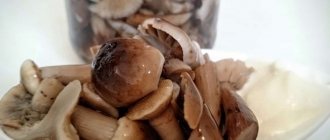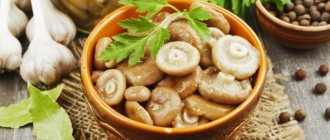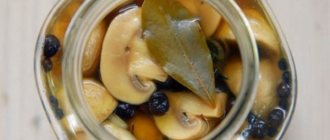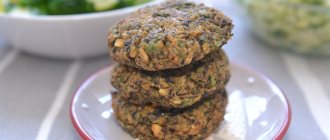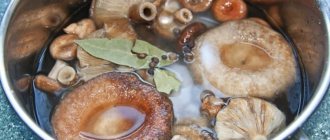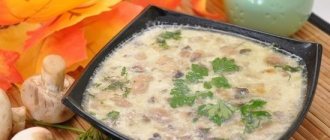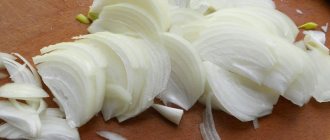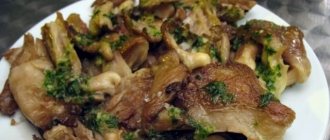Single-barrel mushrooms are one of the most common in the Crimean steppe expanses.
An interesting fact: the time of their collection is quite difficult to unambiguously determine, since it directly depends on weather conditions. There are cases when steppe single-barrels were found even in January (during a dry and warm winter).
Single barrels should be boiled for 30 – 40 minutes.
The most common way to prepare these mushrooms is pickling. To do this, the mushrooms are first cleaned, washed under cold running water, and then boiled for 15 - 20 minutes, periodically skimming off the foam. By the way, mushrooms should be placed in boiling, lightly salted water.
The marinade is prepared in another pan. Surely, every housewife already has the most suitable marinade option for herself. The mushrooms are transferred to the prepared marinade and boiled for another 15 - 20 minutes. Then you can put them in jars prepared in advance for mushrooms and roll them up. Believe me, such a dish will not only please your family at an everyday dinner, but will also decorate the holiday table.
Marinated single barrels can be used both as an independent dish and as an addition to other dishes.
Single barrels should be boiled for 30 – 40 minutes.
Now you know how long to cook single-barrel mushrooms and your mushroom dishes will become even tastier, healthier and more delicious.
Steppe mushroom is an extraordinary fungus. Everything about him is like a real mushroom, only instead of wood there is grass. Most Crimean mushroom pickers call these inhabitants of the steppes steppe oyster mushroom. Indeed, they have signs of similarity, but the name is not entirely accurate. Single-barrel steppe - this is the correct name for this mushroom - only belongs to the same family as oyster mushroom, but has its own characteristics.
Oyster mushroom grows on decaying trees, and oyster mushroom grows in the bare, treeless steppe. This is how P. N. Sigunov describes this fungus: “Near Simferopol there is a single-barrel steppe, a very curious creature. Local residents call it differently: either hoofed, because its leg is woody, or duck, because it waddles like a tired duck. The mushroom looks like a lopsided funnel with rolled edges; the plates are white, sparse and very wide. But that's not the point! It grows very interestingly: not on the ground or on trees, like all normal mushrooms, but on. grass - on prickly tartar, for example, or on field bluehead.”
Read also Protea flower: how to care for cut flowers
It usually lasts from May to November. However, one of the researchers gives an example when, in the warm winter of 1961/62, a single barrel was found in the vicinity of the village. Lugovoi, east of Simferopol, January 23.
It is eaten freshly prepared, or can be pickled. The mushroom can be classified into the third category.
So don't be discouraged if there is no forest near you. Walk around the nearby steppe, look, maybe you will be lucky and you will find steppe mushroom “vegetable gardens”.
Despite the fact that single-barrel mushrooms live throughout southern Eurasia, they can most often be found in Crimea. This is a special variety that has many names and differs from other fruits in its habitat, which often confuses novice mushroom pickers. Due to the fact that they belong to the oyster mushroom family, this mushroom is called steppe oyster mushroom or chanterelle, single-barrel ungulate, duck, although this variety has its own characteristic features.
Characteristics of single-barrel mushrooms
Despite the fact that single-barrel fruits have distinct characteristic features, they can be confused with inedible and even poisonous fruits, so you should be extremely careful when collecting them.
Appearance and photo
The fruit has a wide (from 4 to 30 cm) flat-convex cap with a curled edge. Old individuals can be distinguished by the funnel-shaped shape and smooth skin of the cap. Due to the shape of the cap, inexperienced mushroom pickers may confuse a single barrel with a chanterelle. The color changes from gray (or white) to yellow during the life of the fetus.
The leg is smaller than the cap, has a shape narrowed towards the base and is white or brown in color. The age of the fetus can also be assessed by the very cobwebby, cotton wool-like interior of the stem. Because it is too small, it is often not visible and may give the impression that the mushroom is growing without it at all.
Morphology
The single barrel has rare but fairly wide plates. Its flesh is white and quite dense. Old fruits lose the elasticity of the pulp and it becomes loose. The fruits have a pleasant, faint mushroom smell. The single-barrel mushroom is often called the most delicious mushroom from the Oyster mushroom family. The spores need grass to develop, which explains where the fungi spread.
Place of distribution in Crimea
Mushroom pickers advise going for a rich harvest to the valleys near Mount Demerdzhi, the Bakhchisarai forests, and the steppes near the Donuzlav and Sasyk estuaries. In addition to the Crimean region, single barrels can be found in the Lower Volga region.
Single-barrel oyster mushrooms differ from other varieties of the oyster mushroom family in their rather specific place of growth - they love the grassy cover of the steppe. While all other mushrooms usually grow under trees, single-barrel mushrooms can be found in open, damp areas. During periods of severe drought, you don’t have to look for them, because, despite their steppe habitat, they really love water.
Eating
Single barrels can be eaten and even more so - they are quite valuable for cooking. Mushroom pickers believe that these fruits are the most delicious among all members of the family and therefore are very popular. In addition, this variety contains a large amount of useful substances.
Can be used for drying, pickling, and preparing a variety of dishes. Please note that old mushrooms can only have caps. The legs become rougher with age, sometimes you even have to clean the joints between the knives and the caps.
Collection rules and conditions
Single barrels bear fruit almost all year round, from April until November. In especially warm years, fruits can grow even in early March, so when going into the forest you can almost always find them.
Difference from false, inedible mushrooms
Most often in collection areas you can find false mushrooms, pale toadstools and fly agaric mushrooms. Mushroom pickers advise not to put the entire harvest in one basket and not to rush to collect everything you find in the clearing, because inedible mushrooms grow apart from others.
You can distinguish an edible fruit by the way it grows: unlike many other edible and poisonous mushrooms, the one-barrel mushroom grows in groups and quite often the stems of the fruit are either as close to each other as possible, or even grow together and it seems that the fruit has several caps at once. This is the surest sign of this delicious fruit.
Poisonous Crimean mushrooms
There are approximately 45 species of these. Poisonous mushrooms of Crimea are divided into 5 groups according to their toxicity.
- 5th group: gray entoloma, tiger row, flat-capped champignon. Symptoms of mild poisoning begin between 30 minutes and 5 hours after consumption. The malaise lasts up to a week.
- 4th group: inky and shaggy dung beetles. Poisoning occurs when drinking alcohol at the same time. Therefore, you should not drink it for three days after the mushrooms have been eaten.
- 3rd group: talkers (pale, reddish, orange-red and waxy). All symptoms of poisoning begin 15 minutes after eating mushrooms. Sometimes they lead to the death of a person.
- 2nd group: red and panther fly agarics. Poisoning can often result in death.
- Group 1 - the most poisonous mushrooms, fatal to humans. These include: pale toadstool, spring white and green fly agarics and cherry-brown silverfish. Symptoms begin to appear almost immediately after consuming them.
Although all these mushrooms are poisonous, they can also be useful for humans. Some of them are used by pharmacists to prepare various medicines and are sometimes included in herbal teas for brewing. Of course, the dosage is the minimum.
Useful properties and restrictions on use
Single barrels are valuable not only for their taste, but also for their high content of nutrients. In terms of the amount of vitamins and amino acids, representatives of this variety are close to meat and dairy products. The only vegetables that contain more protein than single-sided vegetables are legumes.
Eating fruits can also help cope with the following diseases and conditions:
- decreased immunity;
- atherosclerosis;
- high cholesterol levels.
Single barrels contain a huge amount of vitamins (especially group B), antioxidants, and beneficial acids. Their effectiveness in the treatment of anemia has been proven, and can be used to influence the symptoms of liver, kidney, and eye diseases.
The mushroom has a unique tonic. Some athletes use single barrels to get a dose of energy before competitions, as a natural alternative to doping drugs. Like other mushrooms, single-barrel mushrooms are not included in the diet of children, pregnant and lactating women, and patients with gastrointestinal pathologies.
Universal marinade for any mushrooms
A simple marinade for mushrooms for the winter is suitable not only for forest products, but also for champignons.
Ingredients:
• water – 1 liter; • cinnamon – 0.4 teaspoon; • salt – 1 tbsp. spoon; • cloves – 3 buds; • sugar – 1 tbsp. spoon; • peppercorns; • vinegar essence – 1 tbsp. spoon; • bay leaf – 1 leaf; • garlic – 3 cloves; • dill umbrellas – 3 pcs.; • horseradish leaves.
Mountain white mushroom
It has many names: giant pigwort, huge leusopaxillus. But the most accurate thing is the giant talker (Trichlomocha family). Prefers the soil of deciduous and coniferous forests. Found from early summer to mid-autumn.
Mountain porcini mushrooms grow in groups. If one is found under a birch or pine tree, there is a high probability that there are several more nearby. It's easy to spot them. The caps are large and fleshy (up to 20 cm in diameter). They can be completely white, but they also come in a pleasant coffee-with-milk color. If the mushroom is completely white, it means it is young and fresh. The hat should be smooth on top and covered with plates with bridges on the bottom.
The stem of a real white mountain mushroom is dense, but rather short, considering the size of the cap - only 3-8 cm. Closer to the cap, there may be villi on it. Sometimes a flour coating is observed. The leg is thickened from below.
The flesh of porcini mushrooms is also white, sometimes creamy. The smell is pleasant. It is described as mealy. Mature mushrooms may have a slightly bitter taste, so they are best used for drying. But in young mushrooms, the taste is more valued, and they contain more nutrients. One of them is the antibiotic clitocybin, which is harmful to the tuberculosis bacillus.
The mushroom can be confused with several other species. The smoky talker looks like him. It is often found in Crimean forests and is slightly inferior to mountain white in taste. It is more dangerous to encounter a poisonous gall mushroom. If you come across a whole clearing of whites, then you need to make sure whether this is a “witch’s” “ring”.
Crimean white mushroom is a welcome guest in every kitchen. It can be consumed stewed, salted, fried, baked or pickled. It can decorate and complement any dish with fried chicken, potatoes, or buckwheat porridge. You can’t list them all.
But mountain mushrooms cannot be stored for a long time. Immediately after collection, it is better to rinse them in cold water and leave them in salted water for half an hour. After cleaning the forest soil and leaves, the mushrooms should be kept in the refrigerator. No more than two days.
Universal marinade
• Time: 40 minutes. • Number of servings: 6 persons. • Calorie content of the dish: 28 kcal. • Purpose: conservation. • Cuisine: Russian. • Difficulty: easy.
This method is excellent for preparing both tubular mushrooms (oyster mushrooms, etc.), and boletuses, chanterelles, etc. Prepare the mushrooms: soak them, chop them and boil them according to the type of fruit, but experts recommend boiling all types of mushrooms for 15 minutes to half an hour. Vinegar can be replaced with vinegar essence, but it is very important to do this correctly, taking into account the proportions.
Boil the water. Add salt, sugar and stir well until completely dissolved.
–Categories
–Search by diary
–Subscription by e-mail
– Regular readers
-Statistics
Thursday, September 14, 2022 19:00 + to quote book
At the beginning of autumn, mushrooms are at their peak in the forests, and mushroom pickers return from a “quiet hunt” with buckets and baskets full of these wonderful gifts of nature. As a result, the collected trophies need to be used somehow: some go for frying, some for drying, and most of the collected mushrooms, as a rule, are pickled or salted. Today we will talk about the 5 best recipes for pickling mushrooms.
Pickling any mushrooms in general is not difficult, but you need to know some of the features of this method of preparing mushrooms. You can marinate porcini mushrooms, greenfinches, goats, chanterelles, boletus mushrooms, boletus mushrooms, row mushrooms, saffron milk mushrooms, aspen mushrooms, boletus mushrooms, russula, fat mushrooms, champignons and other mushrooms. It is important that when pickling, some types of mushrooms should be prepared following certain rules: If the mushrooms are small, they are pickled whole, only the lower part of the stem needs to be cut off; When pickling, large mushrooms are usually cut into 3-4 parts; In the case of boletus and porcini mushrooms, the legs need to be marinated separately from the caps; Remove the skin from the butter before marinating; Valui is soaked for several hours before cooking.
Mice (gray row)
There are several types of rows that can be eaten. But they are quite difficult to distinguish from inedible ones. More often, mice are found in coniferous and mixed forests, in moss or on sandy soil. Rows can grow singly or in groups.
In Crimea they are found in early or mid-autumn. Experienced mushroom pickers go specifically for them to the forests near the village of Kolchugino or to the area of the Crimean Astrophysical Laboratory.
The hats of young mice (5-10 cm) have a conical shape with rolled edges. In mature rows it is flat, fleshy, with irregularities. The edges are unraveled and have small cracks. A small bump protrudes in the center. The plates in it are rare and widely spaced. The color of the cap is gray (from light to dark shade). After rain, it looks slimy and becomes slightly sticky, which causes leaves and small lumps of earth to stick to it, making it difficult to notice.
The stem of the row is dense, long (up to 12 mm), thickened at the base. In mature rows it becomes hollow inside. The color of the leg is pale yellow or grayish below. A plaque is visible next to the cap. The pulp of the mushroom has a dense but fragile structure with a faint powdery odor.
Mice can be salted, boiled, marinated. After boiling, they prefer to fry them and serve them as a tasty addition to main courses. Although they are very tasty in soups, casseroles, salads, and sauces.
Before cooking, they need to be sorted out, removing wormy mushrooms, dirt and pine needles. It is advisable to then soak for two hours in salted water with the addition of citric acid. If the mushrooms have a strong aroma, you can add a bay leaf or a couple of black peppercorns to the water to beat it off.
Mushrooms in Crimea 2022. Top 5 productive villages where you can pick mushrooms in Crimea
Crimea is a peninsula of treasures. Nature, beaches, sights... But there is another tasty, aromatic, sometimes delicious treasure. Let's talk about where in Crimea you can pick mushrooms and when to go for them.
For the little mice in Kolchugino
The village is located near Simferopol. The distance between the settlement and the city is 27 km. Transport is rare, so it’s convenient to rent a car, load baskets in the trunk and go harvesting in comfort.
Mice are also called gray mice. These mushrooms are often small, but giants are not uncommon. They can be found from September to November in coniferous and mixed forests. Mice grow on sandy soils, near old pine trees and simply in fallen leaves and pine needles.
For chanterelles in Mramornoe
The village is located 21 km from Simferopol. This is the mountainous part of Crimea, the western foot of Chatyr-Dag. The most convenient way to get here is also by rented SUV.
Chanterelles are family mushrooms that grow in clusters in open meadows or in the shade of trees. They live in coniferous, mixed forests and birch forests. They can be seen by their wavy caps, which are fused with the legs into a single whole.
For saffron milk caps in Rybachye
If you travel by public transport, you will have to get from Simferopol to the second bus station “Kurortnaya”, and then change to a minibus to the village. You can get there from Alushta by car in an hour if you follow the coastline.
Saffron milk caps usually grow during Indian summer and until the end of October. You need to look for them in a shady place under a pine or spruce tree, in longitudinal grooves, holes, and ravines. These mushrooms are easy to recognize: they have large orange caps and long stems.
For boletus in Zelenogorskoye
Zelenogorskoe is located almost 40 km from Simferopol. You can cover this path in an hour and a few minutes. The village itself is large and has a lot of interesting things to do. For example, a workshop for the production of kumys.
If you like boletus, you can also go to Ai-Petri, where in bright places, around stones, on the edges and clearings you can find many brown caps. They love open areas. When to collect? Not worth it in early summer. In the hot season, insects feed on them. The time is coming closer to autumn.
For steppe oyster mushrooms in Grushevka
Grushevka is located near Sudak. It only takes about 40 minutes to get there. In addition to mushroom places, there are also the remains of two settlements from the Bronze Age and the Middle Ages.
The second name for steppe oyster mushroom is single-barrel. Local residents also give her other funny nicknames: ungulate, duck. An interesting mushroom that grows uniquely - on grass. The harvest can be from late spring to November in spiny tartar or field eryngium.
Are there other places where you can pick mushrooms in Crimea? Certainly. In the village of Nauchny around the observatory there are many suitable areas. Porcini mushrooms are hidden on the South Coast, milk mushrooms - in the Bakhchisarai region, oak mushrooms - in the mountains.
Chanterelles
Another name is cockerels. The lands of the Simferopol region are rich in them. There are many of them near the village of Mramornoe. Mushroom pickers also go to the forests of Belogorsk, Kirov, and Bakhchisarai regions.
Chanterelles grow in numerous groups in sunny places, in clearings or next to clearings. They are also found in moss, among birches, pines, and spruces. Appear from the beginning of June. You can collect all summer until the first autumn frosts.
A distinctive feature of the structure: the mushroom does not have a pronounced transition from the stem to the cap. Uniform color: yellow (shades vary from light to dark, almost orange).
The hat has an irregular shape with wavy, unfolded edges that form a depression in the center. But its surface is absolutely smooth. The leg tapers downwards, the length is about 5 cm. The flesh is fleshy, dense, with a slightly sour taste. When pressed, it acquires a reddish tint. The smell is weak.
It must be distinguished from the false chanterelle, whose cap has no bends and resembles small funnels. In addition, their color is always orange, closer to red. The yellow hedgehog also looks like a chanterelle. This is an edible yellow mushroom. It has a fleshier cap and a thicker white stalk.
Chanterelles are very good for health. They help get rid of helminths, have a beneficial effect on liver cells (containing ergosterol in mushrooms), and are a source of vitamins. Increases the body's resistance to infections.
Description of steppe oyster mushroom
Eringi, like any other mushroom, has characteristic features of appearance and taste, which allows it to occupy a leading position among the preferences for collection among mushroom pickers.
hat
The diameter of the cap of the steppe oyster mushroom varies greatly in different periods of growth. Young specimens have a cap of 4.5 cm, fully mature ones - about 13 cm. At the beginning of growth, a small tubercle is located in the center of the cap, which over time turns into a depressed spot. The color of the surface of the cap is red-brown (in a young mushroom) and brownish, pale ocher with white edges in an adult specimen. The structure of the skin of the cap is fibrous or finely scaly, smooth to the touch.
Hymenophore
The hymenophore is highly developed, which allows it to produce the maximum number of spores, and therefore the single barrel grows in large families. The plates located under the cap partially extend onto the stem. Planted densely. The color of the plates is creamy pink and has an evenly colored solid edge. The spores are beige in color, narrowly elliptical or cylindrical in shape.
Pulp
Steppe oyster mushroom is distinguished by its meatiness due to its large size and volume of tissue. The pulp is dense in young mushrooms, while in overripe ones it is looser, has a white or light yellow color, sometimes with a brown or pink tint. Oyster mushroom does not have a pronounced mushroom smell. The taste of the pulp is pleasant, mushroom.
Did you know? There is a mushroom in the world that does not have a stem and can move by waddling from one side to the other. It's called Plasmodium
»and in appearance it very much resembles a shrunken jellyfish - translucent and gelatinous.
Autumn honey mushrooms
Real autumn honey mushrooms are collected everywhere from the end of August to the end of autumn. These mushrooms almost never grow alone. They usually parasitize whole families on trees and stumps. Prefer moist soil.
In young honey mushrooms, the cap is concave inward, with growth it opens and becomes flat (size from 2 to 15 cm). The legs are long - up to 10 cm. The color of the caps and legs is the same - honey, but they have flake-like scales of a dark color, which is why honey mushrooms look brownish and slightly fluffy. There is a filmy ring under the cap.
False poisonous honey mushrooms have a gray-yellow color. The cap is whitish at the edges and has no scales. The pulp is light yellow with a bitter taste and earthy smell. The spore powder is brown, while in the autumn honey mushroom it is white.
Honey mushrooms can be prepared in different ways. It is better to boil peeled honey mushrooms in salted water for about five minutes. Be sure to then place them in a colander and allow the water to drain. Before serving, they are crushed, poured with sour cream or sprinkled with green onions. For pickling, cook for 20 minutes, after rinsing and removing dirt. After cooking, place in a glass container, add bay leaf, pepper, onion and dill. It is good to place mushrooms and additives in layers, one on top of the other.
Recipes and cooking features
The most common and easiest way to cook single barrels is to marinate. To do this, you will need to rinse well and clean the fruits from soil, sand, and grass residues. After this, you should boil the water - the mushrooms should be added only after boiling. On average, they need to be cooked for no longer than 30-40 minutes, stirring occasionally and skimming off the foam. The marinade recipe for steppe mushrooms is very simple.
To prepare, you will need the following ingredients (per 1 liter of water):
- 3 teaspoons vinegar;
- 2 tablespoons each of crystalline sugar and salt;
- a pair of bay leaves;
- pepper and cloves to taste.
As soon as you see that the fruits have settled to the bottom of the pan, you can remove them from the heat and put them in jars, immediately pouring them with the pre-prepared marinade. Then roll up the cans and place them upside down, wrap them up.
Pickled oyster mushrooms
You can also prepare very tasty hot sandwiches, which are suitable for a gourmet breakfast, as an addition to soup, and as a snack on the holiday table. To prepare the dish, you need to take:
- slices of white bread or toast;
- a small amount of vegetable oil for frying.
Filling:
- smoked bacon;
- onion;
- mushrooms (about 200 g);
- hard, melting cheese (100-150 g is enough);
- sour cream and spices (salt, pepper, etc.) to taste.
Hot sandwiches with oyster mushrooms
Chop all the ingredients for the filling and fry them over medium heat until cooked. At the end of frying, add a little sour cream to make the appetizer tender. All that remains is to cut the bread and put the filling on it, tightly sprinkling everything with grated cheese.
Next, place the sandwiches in the preheated oven and leave there until the cheese melts. The appetizer is served hot; for aesthetics, you can garnish it with a few sprigs of parsley or other herbs to taste.
Common boletus
They are distributed everywhere, but there are especially many of them in the Belogorodsky region of Crimea, in the village of Zelenogorskoye, as well as in Strogonovka and on the Ai-Petri plateau. Growing season: June – end of October. They love bright meadows and forest edges. Found in meadows. Insects like to eat boletus, so in the summer mushrooms are often simply eaten away by them. But by autumn the situation will normalize.
It is very difficult to confuse boletus with other mushrooms. Their name speaks for itself. The fleshy, juicy caps seem to be smeared with oil: they are slippery and slimy, brown or light brown in color. In mature butterflies, the caps open, taking on the shape of hemispheres. The older the mushroom, the higher the edges. The skin is easy to separate from the pulp. Under the cap there is a tubular layer with small yellow pores.
The legs are lighter than the cap, thin, up to 10 cm long. A white ring is clearly visible on a mature mushroom.
Butternuts cannot be stored for a long time, so after harvesting they must be cooked quickly. Before cooking (frying, boiling, canning), you need to remove the thick skin and sort them. All wormy mushrooms are thrown away. Then they are soaked for an hour in water with salt and completely cleaned of dirt.
Before marinating, they are boiled for 15-20 minutes. During cooking, you can add a little onion to the water, this will add piquancy to the future dish. Next, they need to be tipped into a colander and dried a little. Pickled in any way.
The boletus is frozen, boiled in water (cooking time - 5 minutes), dried and placed in small portions in plastic bags. After defrosting, butter mushrooms are stored for only a short time, so you only need to take out the required amount of mushrooms from the freezer.
Cooking for 1 liter of water
The taste of mushrooms directly depends on the marinade. It must be prepared in the correct proportions, strictly following the recipe.
Ingredients:
• water – 1 liter; • bay leaf – 2 leaves; • sugar – 2 tbsp. heaped spoons; • black peppercorns; • cloves – 5 pcs.; • salt – 1 tbsp. heaped spoon; • allspice peas; • table vinegar (9%) – 3 tbsp. spoons.
Preparation:
1. Boil water. Throw in the bay leaves and cloves. Add salt. Add sugar and add peppercorns. Boil for five minutes until the crystals are completely dissolved. 2. Pour in the vinegar, stir and pour into the prepared jar of mushrooms. Roll up.
Milk mushrooms
Mushroom pickers come across mushroom pickers in mixed forests in the summer. Rarely found in the foothills and mountainous regions of Crimea. The main harvest season is July and September. Active growth begins after heavy rains.
There are no real milk mushrooms in Crimea, but oak, pepper and dry milk mushrooms grow. Pepper milkweed can be distinguished by its funnel-shaped white cap with grayish spots. On its narrow plates drops of milky juice are noticeable, which tastes very bitter. The leg is short, narrowed below. You can eat the mushroom after repeated soaking.
The dry milk mushroom also has a white cap, but with brown spots. The plates have a bluish color. The bitter juice does not appear after breaking. The mushroom is ideal for pickling and pickling (after pre-soaking).
In the mountainous part of Crimea you can find oak milk mushrooms. These reddish lamellar mushrooms grow in deciduous forests. Brown stripes are easily visible on their caps. Legs with yellow pits lose their density as they grow. Suitable for marinating, frying, boiling.
Mushroom marinade recipes
Pickling mushrooms at home is not such a complicated process; every housewife can handle it. It is worth remembering that it must be approached responsibly and be sure to take into account the variety of forest fruits. There is a recipe for a marinade for mushrooms with and without pre-soaking, a special way to cook boletus and chanterelles with garlic, a quick recipe for pickling mushrooms for consumption in 3-5 days, and others.
Saffron milk caps
Appear in forests from July. They love shade and cool places under trees. They grow in large groups. In Crimea, their recognized place is Rybachye; they are also often found in the forests of the southern coast of Crimea.
The orange caps grow up to 12 cm in diameter. The bottom has reddish plates that turn green when pressed. the skin on them is a little sticky. The hollow legs, up to 2 cm thick, have dimples. The flesh of saffron milk caps is dense, sweet and has a fruity aroma.
Ryzhiki can be prepared in any way. They are salted very quickly: within two hours you get delicious salted mushrooms. The main thing is to add more spices.
Raincoats
Puffballs are mushrooms that cannot be poisoned. But when collecting them, you still need to check their flesh: in a real raincoat it is always white. Giant and pear-shaped raincoats are common in Crimea. The first has a fruit body that is round and white, but becomes yellowish over time. Can reach a height of 34 cm.
The fruiting body of the pear-shaped puffball is very similar in shape to a pear. The skin is rough with small tubercles. Raincoats grow in the foothills, choosing rotten wood for themselves.
Only young mushrooms are suitable for food. They are dried or fried. They also make a delicious mushroom soup. In terms of nutritional content they can be compared with white ones.
>
Where to pick mushrooms in Crimea
There are a lot of mushroom places in Crimea. Forest hotels can be found both in the mountains of the peninsula and in the steppe zone. In October, in a young pine forest, in the mountains from the village of Stroganovka, it was possible to collect “butterfly”, and now in this place they are collecting “butterfly” or gray row.
Many connoisseurs of quiet hunting are attracted by the Crimean Mountains. Here, at altitudes of 300–700 meters, you can collect significant prey. Rich in mushrooms and yayla - the flat tops of mountain ranges. Many mushroom pickers have heard about Ai-Petrinskaya Yayla. Another mushroom place in Crimea is the outskirts of Sevastopol, where the forest stretches towards Bakhchisarai. In the east of the peninsula you can wander through the forests from Old Crimea to Feodosia.
But not only forests are of interest to mushroom pickers. The steppes can also present a pleasant surprise. Some types of mushrooms can be collected in the fields around the Donuzlav and Sasyk estuaries. In addition, forests in Luchistoye and the area of Mount Demerdzhi are considered good mushroom places.
They also find mushroom places near Sevastopol, where the forest stretches towards Bakhchisarai. In the eastern part of the peninsula, mushrooms can be collected in forests from Feodosia to Old Crimea. According to Simferopol mushroom pickers, most of the “mice” grow in the forest in the village of Kolchugino and in the area of the Crimean Astrophysical Observatory, boletus - in Zelenogorskoe and Stroganovka, saffron milk caps - near Rybachye, chanterelles can be found in Mramornye.
Map of Crimea.
